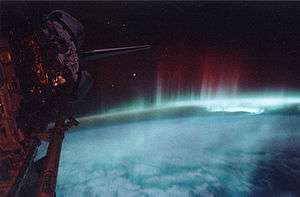Plants in space
The growth of plants in outer space has elicited much scientific interest.[1] In the late 20th and early 21st century, plants were often taken into space in low Earth orbit to be grown in a weightless but pressurized controlled environment, sometimes called space gardens.[1] In the context of human spaceflight, they can be consumed as food and/or provide a refreshing atmosphere.[2] Plants can metabolize carbon dioxide in the air to produce valuable oxygen, and can help control cabin humidity.[3] Growing plants in space may provide a psychological benefit to human spaceflight crews.[3] Usually the plants were part of studies or technical development to further develop space gardens or conduct science experiments.[1] To date plants taken into space have had mostly scientific interest, with only limited contributions to the functionality of the spacecraft, however the Apollo Moon tree project was more or less forestry inspired mission and the trees part of a country's bicentennial celebration.
.jpg)
.jpg)
The first challenge in growing plants in space is how to get plants to grow without gravity.[4] This runs into difficulties regarding the effects of gravity on root development, providing appropriate types of lighting, and other challenges. In particular, the nutrient supply to root as well as the nutrient biogeochemical cycles, and the microbiological interactions in soil-based substrates are particularly complex, but have been shown to make possible space farming in hypo- and micro-gravity.[5][6]
NASA plans to grow plants in space to help feed astronauts, and to provide psychological benefits for long-term space flight.[7] In 2017, aboard ISS in one plant growth device, the 5th crop of Chinese cabbage (Brassica rapa) from it included an allotment for crew consumption, while the rest was saved for study.[8] An early discussion of plants in space, were the trees on the brick moon space station, in the 1869 short story "The Brick Moon".[9]
History
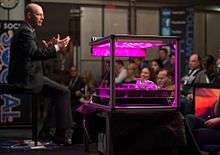
In the 2010s there was an increased desire for long-term space missions, which lead to desire for space-based plant production as food for astronauts.[10] An example of this is vegetable production on the International Space Station in Earth orbit.[10] By the year 2010, 20 plant growth experiments had been conducted aboard the International Space Station.[1]
Several experiments have been focused on how plant growth and distribution compares in micro-gravity, space conditions versus Earth conditions. This enables scientists to explore whether certain plant growth patterns are innate or environmentally driven. For instance, Allan H. Brown tested seedling movements aboard the Space Shuttle Columbia in 1983. Sunflower seedling movements were recorded while in orbit. They observed that the seedlings still experienced rotational growth and circumnation despite lack of gravity, showing these behaviors are instinctual.[11]
Other experiments have found that plants have the ability exhibit gravitropism, even in low-gravity conditions. For instance, the ESA's European Modular Cultivation System[12] enables experimentation with plant growth; acting as a miniature greenhouse, scientists aboard the International Space Station can investigate how plants react in variable-gravity conditions.The Gravi-1 experiment (2008) utilized the EMCS to study lentil seedling growth and amyloplast movement on the calcium-dependent pathways.[13] The results of this experiment found that the plants were able to sense the direction of gravity even at very low levels.[14] A later experiment with the EMCS placed 768 lentil seedlings in a centrifuge to stimulate various gravitational changes; this experiment, Gravi-2 (2014), displayed that plants change calcium signalling towards root growth while being grown in several gravity levels.[15]
Many experiments have a more generalized approach in observing overall plant growth patterns as opposed to one specific growth behavior. One such experiment from the Canadian Space Agency, for example, found that white spruce seedlings grew differently in the anti-gravity space environment compared with Earth-bound seedlings;[16] the space seedlings exhibited enhanced growth from the shoots and needles, and also had randomized amyloplast distribution compared with the Earth-bound control group.[17]
Early efforts
The first organisms in space were "specially developed strains of seeds" launched to 134 km (83 mi) on 9 July 1946 on a U.S. launched V-2 rocket. These samples were not recovered. The first seeds launched into space and successfully recovered were maize seeds launched on 30 July 1946. Soon followed rye and cotton. These early suborbital biological experiments were handled by Harvard University and the Naval Research Laboratory and were concerned with radiation exposure on living tissue.[18] In 1971, 500 tree seeds (Loblolly pine, Sycamore, Sweetgum, Redwood, and Douglas fir) were flown around the Moon on Apollo 14. These Moon trees were planted and grown with controls back on Earth where no changes were detected.
Space station era
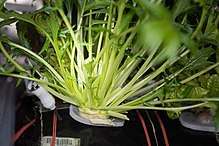
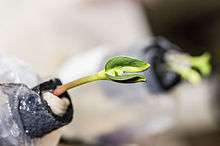
In 1982, the crew of the Soviet Salyut 7 space station conducted an experiment, prepared by Lithuanian scientists (Alfonsas Merkys and others), and grew some Arabidopsis using Fiton-3 experimental micro-greenhouse apparatus, thus becoming the first plants to flower and produce seeds in space.[20][21] A Skylab experiment studied the effects of gravity and light on rice plants.[22][23] The SVET-2 Space Greenhouse successfully achieved seed to seed plant growth in 1997 aboard space station Mir.[3] Bion 5 carried Daucus carota and Bion 7 carried maize (aka corn).
Plant research continued on the International Space Station. Biomass Production System was used on the ISS Expedition 4. The Vegetable Production System (Veggie) system was later used aboard ISS.[24] Plants tested in Veggie before going into space included lettuce, Swiss chard, radishes, Chinese cabbage and peas.[25] Red Romaine lettuce was grown in space on Expedition 40 which were harvested when mature, frozen and tested back on Earth. Expedition 44 members became the first American astronauts to eat plants grown in space on 10 August 2015, when their crop of Red Romaine was harvested.[26] Since 2003 Russian cosmonauts have been eating half of their crop while the other half goes towards further research.[27] In 2012, a sunflower bloomed aboard the ISS under the care of NASA astronaut Donald Pettit.[28] In January 2016, US astronauts announced that a zinnia had blossomed aboard the ISS.[29]
In 2017 the Advanced Plant Habitat was designed for ISS, which was a nearly self-sustaining plant growth system for that space station in low Earth orbit.[30] The system is installed in parallel with another plant grown system aboard the station, VEGGIE, and a major difference with that system is that APH is designed to need less upkeep by humans.[30] APH is supported by the Plant Habitat Avionics Real-Time Manager.[30] Some plants that were to be tested in APH include Dwarf Wheat and Arabidopsis..[30] In December 2017 hundreds of seeds were delivered to ISS for growth in the VEGGIE system.[31]
In 2018 the Veggie-3 experiment was tested with plant pillows and root mats.[32] One of the goals is to grow food for crew consumption.[32] Crops tested at this time include cabbage, lettuce, and mizuna.[32] In 2018, the PONDS system for nutrient deliver in microgravity was tested.[33] In December 2018, the German Aerospace Center launched the EuCROPIS satellite into low Earth orbit. This mission carries two greenhouses intended to grow tomatoes under simulated gravities of the Moon and Mars using by-products of human presence in space as source of nutrients.
Chang'e 4 lunar lander in January 2019, carried a 3 kg (6.6 lb) sealed "biosphere" with seeds and insect eggs to test whether plants and insects could hatch and grow together in synergy.[34] The experiment included seeds of potatoes, tomatoes, and Arabidopsis thaliana (a flowering plant), as well as silkworm eggs. These became the first plants grown on the Moon. Environmental systems will keep the container hospitable and Earth-like, except for the low lunar gravity.[35] If the eggs hatch, the larvae would produce carbon dioxide, while the germinated plants would release oxygen through photosynthesis. It is hoped that together, the plants and silkworms can establish a simple synergy within the container. A miniature camera will photograph any growth. The biological experiment was designed by 28 Chinese universities.[36]
Plants grown in space

Plants grown in space include:
- Arabidopsis (Thale cress)[4][37]
- Bok choy (Tokyo Bekana) (Chinese cabbage)[38]
- Super dwarf wheat[3]
- Apogey wheat[3]
- Brassica rapa[3]
- Rice[22]
- Tulips[37]
- Kalanchoe[37]
- Flax[37]
- Onions, peas, radishes, lettuce, wheat, garlic, cucumbers, parsley, potato, and dill[37]
- Lettuce and Cinnamon basil[39]
- Cabbage[32]
- Zinnia hybrida ("Profusion" var.)[40]
- Mizuna lettuce[1]
- Red romaine lettuce ("Outredgeous" var.)[41]
- Sunflower[19]
- Ceratopteris richardii[42]
Experiments

Some experiments involving plants include:
- Advanced Plant Habitat[43]
- Bion satellites
- Biomass Production System, aboard ISS
- Vegetable Production System (Veggie), aboard ISS.[44]
- SVET[3]
- SVET-2, aboard Mir.[3]
- Lada greenhouse (aka Lada Validating Vegetable Production Unit)[1]
- ADVASC
- TAGES, aboard ISS.[45]
- Plant Growth/Plant Phototropism, aboard Skylab[22]
- Oasis plant growth unit[46]
- Plant Signaling (STS-135)[47]
- Plant growth experiment (STS-95)[48]
- NASA Clean Air Study
- ECOSTRESS, 2018[49][50]
- Chang'e 4 lunar lander "biosphere" with seeds and insect eggs to test whether plants and insects could hatch and grow together in synergy.[34]
- SpaceMoss, a NASA experiment studying the growth of the moss Physcomitrella patens in microgravity. This experiment will launch on CRS-18 on July 25, 2019, and will be performed aboard the ISS.[51]
See also
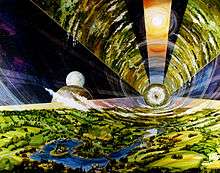
- Astrobotany
- Bioastronautics
- Biolab (Payload rack on Columbus laboratory of the International Space Station)
- Bion
- BIOPAN
- Biosatellite program (series of space biology satellites and experiments)
- Endolith (long lived microorganisms that live inside rocks)
- EXPOSE (ISS experiment that tested organisms in LEO)
- List of microorganisms tested in outer space
- Moon tree (trees grown from space-flown seeds)
- O/OREOS (orbited Halorubrum chaoviatoris and Bacillus subtilis)
- Space food (Plant have formed a component of astronaut food as well)
- Terraforming
- The Martian, a 2015 American science fiction film in which potatoes are grown on Mars
References
- "NASA - Growing Plants and Vegetables in a Space Garden". Nasa.gov. Retrieved 13 February 2019.
- Wild, Flint (24 June 2013). "Plants in Space". Nasa.gov. Retrieved 13 February 2019.
- "T.Ivanova, et al. - First Successful Space Seed-to-Seed Plant Growth Experiment in the SVET-2 Space Greenhouse in 1997" (PDF). Space.bas.bg. Retrieved 13 February 2019.
- Administrator, NASA (7 June 2013). "Getting to The Root of Plant Growth Aboard The Space Station". Nasa.gov. Retrieved 13 February 2019.
- Maggi F. and C. Pallud, (2010), Martian base agriculture: The effect of low gravity on water flow, nutrient cycles, and microbial biomass dynamic, Advances in Space Research 46, 1257-1265, doi:10.1016/j.asr.2010.07.012
- Maggi F. and C. Pallud, (2010), Space agriculture in micro- and hypo-gravity: A comparative study of soil hydraulics and biogeochemistry in a cropping unit on Earth, Mars, the Moon and the space station, Planet. Space Sci. 58, 1996–2007, doi:10.1016/j.pss.2010.09.025.
- Rainey, Kristine (7 August 2015). "Crew Members Sample Leafy Greens Grown on Space Station". Nasa.gov. Retrieved 23 January 2016.
- Heiney, Anna (17 February 2017). "Cabbage Patch: Fifth Crop Harvested Aboard Space Station". NASA. Retrieved 11 May 2018.
- "The Atlantic Monthly". En.wikisource.org. Retrieved 13 February 2019.
- Rainey, Kristine (2 March 2015). "Veggie will Expand Fresh Food Production on Space Station". Nasa.gov. Retrieved 13 February 2019.
- Chamovitz, Daniel (2012). What a plant knows : a field guide to the senses (1st ed.). New York: Scientific American/Farrar, Straus and Giroux. ISBN 978-0-374-28873-0.
- Jost, Ann-Iren Kittang; Hoson, Takayuki; Iversen, Tor-Henning (20 January 2015). "The Utilization of Plant Facilities on the International Space Station—The Composition, Growth, and Development of Plant Cell Walls under Microgravity Conditions". Plants. 4 (1): 44–62. doi:10.3390/plants4010044. ISSN 2223-7747. PMC 4844336. PMID 27135317.
- Driss-Ecole, Dominique; Legué, Valérie; Carnero-Diaz, Eugénie; Perbal, Gérald (1 September 2008). "Gravisensitivity and automorphogenesis of lentil seedling roots grown on board the International Space Station". Physiologia Plantarum. 134 (1): 191–201. doi:10.1111/j.1399-3054.2008.01121.x. ISSN 1399-3054. PMID 18429941.
- "Scientific objectives". Lensesinspace.wordpress.com. 28 March 2014.
- "A decade of plant biology in space". European Space Agency.
- "NASA - Advanced Plant Experiment - Canadian Space Agency 2". Nasa.gov.
- Rioux, Danny; Lagacé, Marie; Cohen, Luchino Y.; Beaulieu, Jean (1 January 2015). "Variation in stem morphology and movement of amyloplasts in white spruce grown in the weightless environment of the International Space Station". Life Sciences in Space Research. 4: 67–78. Bibcode:2015LSSR....4...67R. doi:10.1016/j.lssr.2015.01.004. PMID 26177622.
- Beischer, DE; Fregly, AR (1962). "Animals and man in space. A chronology and annotated bibliography through the year 1960". US Naval School of Aviation Medicine. ONR TR ACR-64 (AD0272581). Retrieved 14 June 2011.
- "Photo-iss038e000734". Spaceflight.nasa.gov. Retrieved 13 February 2019.
- "First species of plant to flower in space". Retrieved 20 January 2016.
- "No NASA, These Are Not The First Plants To Flower In Space". Retrieved 20 January 2016.
- "0102081 - Plant Growth/Plant Phototropism - Skylab Student Experiment ED-61/62". Mix.msfc.nasa.gov. Archived from the original on 17 March 2016. Retrieved 13 February 2019.
- "ch5". History.nasa.gov. Retrieved 13 February 2019.
- Office, ISS Program Scientist. "NASA - Vegetable Production System". Nasa.gov. Retrieved 13 February 2019.
- "NASA - Station Investigation to Test Fresh Food Experience". Nasa.gov. Retrieved 13 February 2019.
- Why Salad in Space Matters, Jeffrey Kluger, Time, 10 August 2015
- Bauman, Joe (16 June 2003). "USU EXPERIMENT FEEDS ASTRONAUTS' MINDS, TASTE BUDS". Deseret News, Space Dynamics Laboratory.
- "June 17–26 – Diary of a Space Zucchini". Retrieved 20 January 2016.
- Behold the first flower to bloom in space, a cheerful zinnia, Cnet, 18 January 2016
- Herridge, Linda (2 March 2017). "New Plant Habitat Will Increase Harvest on International Space Station". NASA. Retrieved 11 May 2018.
- "Zero gravity plant growth experiments delivered to space station". EurekAlert!. Retrieved 11 May 2018.
- "NASA Space Station On-Orbit Status 6 February 2018 - Celebrating 10 Years of ESA's Columbus Module - SpaceRef". Spaceref.com. Retrieved 8 February 2018.
- "NASA - Veggie PONDS". Nasa.gov. Retrieved 13 February 2019.
- David, Leonard. "Comsat Launch Bolsters China's Dreams for Landing on the Moon's Far Side". Scientific American. Archived from the original on 29 November 2018.
- China Is About to Land Living Eggs on the Far Side of the Moon. Yasmin Tayag, Inverse. 2 January 2019.
- Chang'e-4: China mission primed for landing on Moon's far side. Paul Rincon, BBC News. 2 January 2019.
- "Growing Pains". Air & Space Magazine. Retrieved 13 February 2019.
- Griffin, Amanda (17 February 2017). "Cabbage Patch: Fifth Crop Harvested Aboard Space Station". Nasa.gov. Retrieved 28 March 2017.
- "NASA - A Plant Growth Chamber". Nasa.gov. Retrieved 13 February 2019.
- Dean, James (29 December 2015). "ISS space flowers may need some help from 'Martian'". Florida Today. Retrieved 19 April 2017.
- Smith, Steve (10 August 2015). "'Outredgeous' Red Romaine Lettuce, Grown Aboard The International Space Station, To Be Taste-Tested By Astronauts". Medical Daily. Pulse. Retrieved 19 April 2017.
- Salmi, Mari L.; Roux, Stanley J. (1 December 2008). "Gene expression changes induced by space flight in single-cells of the fern Ceratopteris richardii". Planta. 229 (1): 151–159. doi:10.1007/s00425-008-0817-y. PMID 18807069.
- "NASA - Advanced Plant Habitat". Nasa.gov. Retrieved 13 February 2019.
- "NASA - Station Investigation to Test Fresh Food Experience". Nasa.gov. Retrieved 23 January 2016.
- "Glow-in-the-Dark Plants on the ISS - Science Mission Directorate". Science.nasa.gov. Retrieved 13 February 2019.
- "Encyclopedia Astronautica Index: 1". Astronautix.com. Retrieved 13 February 2019.
- Plant Signaling (STS-135) Archived 16 February 2013 at the Wayback Machine
- Shimazu T, Aizawa S (1999). "STS-95 Space Experiments (plants and cell biology)". Biol Sci Space. 13 (1): 25–32. doi:10.2187/bss.13.25. PMID 11542477.
- NASA's New Space 'Botanist' Arrives at Launch Site. NASA. 17 April 2018.
- ECOSTRESS - Home web site at NASA.
- "Environmental Response and Utilization of Mosses in Space – Space Moss". www.nasa.gov. Retrieved 25 July 2019.
External links
| Wikimedia Commons has media related to Plants in space. |
- Plants in space projects
- STS-118 Plant Growth
- Greenhouses for Mars
- Sunlight on Mars: Is there enough light on mars to grow tomatoes?
- Award-winning Mars garden
- Plant biology at low atmospheric pressures in support of Earth-orbital, lunar, or Martian plant growth facilities
- How Plants Know Which Way Is Up
